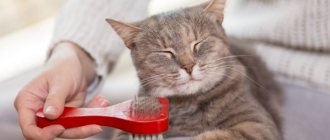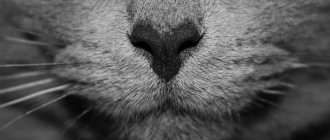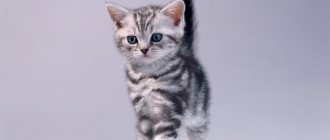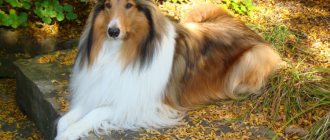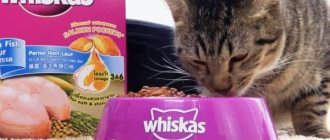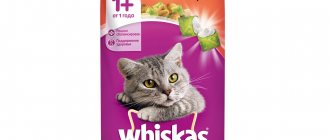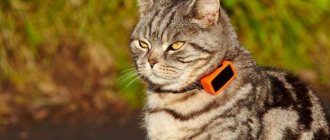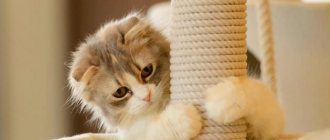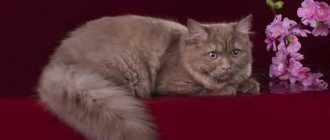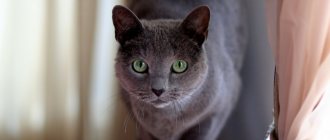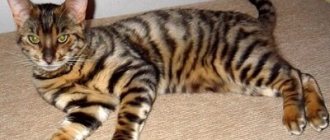3758Administration
Advertising videos offering to feed your pet Whiskas food are made of very high quality, and they feature a charming kitten with an unusual color. Because of this, the question often arises, what breed of cat is this from the Whiskas advertisement. It is difficult to find a person who does not want to have such a cute pet. Everyone who has decided to buy such a baby for themselves wants to know the exact name of the breed and color of the kitten they like so much.
When cats appear in Wiskas commercials, the chosen kittens and adult animals are British Shorthairs with a silver tabi color, of which there are several subtypes.
© shutterstock
Who is he - a funny plush kitten
The breed is called British Shorthair. There are several standard colors. The kitten from the Whiskas advertisement is a black, silver tabby. Characterized by the presence of dark patterns on a light background. Eyes green or yellow. There is a mark on the forehead in the form of the letter M. Tabby has several variations.
- Mackerel or tiger. There are thin tiger stripes on a light silver background.
- Spotted. Characterized by the presence of intermittent stripes and spots of different shapes and sizes.
- Marble. With spiral wide stripes.
Those who watch Whiskas advertising carefully have probably noticed that all the kittens are of different colors. But the one that stands out the most is the handsome mackerel. The kittens grew up in a British nursery. They have been appearing in commercials since 2003. Interestingly, cats of different breeds took part in the shooting: Burmese, Bengal. But for some reason the British kitten won the hearts of the audience.
This is interesting: Instructions for using Forvet for cats
Tabby color varieties
This coat color has several varieties:
Spotted tabby kitten
- Tiger tabby, or mackerel. Cats of this color resemble tigers in appearance. Like their predatory relatives, their fur coat has characteristic stripes of a darker shade than the main background, which stretch from the back to the stomach. The value of the animal depends on the number of vertical stripes and their clarity.
- Spotted tabby, or spotted. Animals with this color have dark spots of the same size evenly distributed throughout the body. There is an intermittent dark stripe on the back.
- Marble tabby, reminiscent of the pattern on marble.
- Ticked tabby, also known as Abyssinian. Each fur of the owners of this color is painted in 2-3 colors.
Whiskas cats, regardless of the pattern on their body, should have:
- the letter "M" on the forehead;
- a “necklace” on the chest, which can be either closed or open;
- stripes on paws;
- tail rings;
- 1–2 rows of markings on the belly;
- contrasting pattern on the back;
- a light spot on the outside of both ears;
- eyeliner and nose in the color of the main background of the body.
What kind of animal is this - a British shorthair cat?
Now almost everyone knows what a British Shorthair looks like. And it’s hard to understand how such a cute baby can be the cub of such a serious and plush cat. Some people think that British cats are gray (more precisely, lilac) or white, black, or, less commonly, saffron milk caps. But few people have seen tabby shorthair cats of the British breed. But it was this cat that starred in the commercial.
Why is Whiskas the cat so popular?
Not all people are loyal to advertising on television or on the Internet. But, whatever one may say, it has become an integral part of the life of a modern person. Advertising is a time when the human brain perceives information primarily superficially, that is, literally lets it pass by.
Many people like the cat from popular advertising
But who doesn’t stop their gaze on the screen when the face of everyone’s favorite animal appears there? This adorable cat from a cat food commercial has won the hearts of viewers. Its characteristic, memorable color has long branded all cats of this breed as the “Whiskas cat.”
Cat breed from Whiskas food advertisement
When a person who is just thinking about what breed of kitten to get, he involuntarily pays attention to the options that are most accessible to the eye. Today these are animals from commercials. Then many people have a question about the breed of cat from Whiskas. The Whiskas cat is a British Shorthair breed.
Note! The color of the kitten in the advertisement is called silver tabby, and today this color is the most popular among British Shorthair cats. Perhaps this was facilitated by the extensive advertising of Whiskas with a cat of this breed in the leading role.
What is the real name of the British Whiskey color?
Some ignorant people think that such a color really exists. In fact, cats do not have this shade, just as there is no breed with this name. A commercial for cat food stars a British kitten with one of the most popular colors - a tabby brindle variety. It also has another name - black and silver mackerel. You can see in the photo what a British kitten looks like from a cat food advertisement.
Acquaintance
So, I won’t bother you with a long wait, and... drum roll: the cat from the Whiskas ad is a British Shorthair. Today, all over the world, British cats are considered the most popular.
The cats, or rather the kittens from the commercial, were born and raised in Germany in a nursery called “Silver Treasure”. The kittens of this nursery have become recognizable since 2003. Can you imagine how much time has already passed? But it was the British with the “silver tabby” color that viewers fell in love with. You can often find the color “brindle” or “merle tabby”. A breed with this color is considered new, bred by pet lovers, not by felinologists. It is noteworthy that in recent years a characteristic feature has been the naming of a cat’s breed after the name of the food it advertises.
Having learned what breed of cat is in the Whiskas advertisement, many people rush headlong to buy it. But first you should find out the prices. Thoroughbred British are unlikely to be handed over to “good hands” for free. Imagine, the cost of a kitten from a commercial (not the same one, but a similar one) varies between 25-100 dollars. Purebred young pets with a rare color can cost about 250-350 dollars.
Why did British Shorthairs win the tender to appear in the Whiskas commercial?
The cat from the Whiskas advertisement is the face of the brand. Why was this breed given such honor? Everything is so banal. When a TV viewer sees such a baby, he understands that the “British” is the personification of an ideal (in every sense) pet: so calm, sweet, balanced, well-groomed and unrivaled. This breed is capable of unbalancing (in a good way) even the most unemotional and secretive person: you just want to cuddle the baby.
The British Shorthair breed was chosen because it has the following qualities:
- ideal composition, harmony and proportionality of the body;
- dense and thick tabby coat resembles a plush blanket;
- adult Scottish Straight animals and kittens are equally attractive to television viewers;
- absence of signs indicating the exclusivity of the breed.
As already mentioned, representatives of the breed for advertising are raised in a German nursery. The key to success is to comply with the following laws:
- good heredity;
- proper care;
- balanced, proper nutrition;
- constant examination by veterinarians;
- natural selection.
Only by complying with the above standards do breeders raise energetic, attractive, healthy pets. Moreover, kittens with the most touching and sweet faces are selected for advertising.
Cat from an advertisement for Sheba food
Many people know Sheba products; some even purchase food from this brand for their pet. Only advertising will make it possible to popularize food around the world. Three commercials from this manufacturer are familiar to Russian TV viewers. And in each of them there are individuals of different breeds: Scottish Fold, British Shorthair, etc.
But the video in which Eva Langoria and the magnificent cat Nick, who really became the face of the brand, became especially popular in the history of “Sheba”.
Nick is a representative of the Russian Blue breed. In Sheba advertisements, the cats are usually a solid color, smoke or silver. Nick fit this category perfectly. Moreover, animals of this breed have a beautiful, powerful physique, are graceful, photogenic and are highly trainable. In addition, a furry actor was chosen to match a famous actress and had to match.
Description of the breed and character of the “British”
Now it’s time to move on to the description of the British cat breed. According to standards, a pet must have the following characteristics:
- size: large or medium;
- back: strong and massive;
- chest: wide;
- neck: short and massive;
- strong paws and short stature;
- tail: thick, short with a round tip;
- well developed and pronounced chin;
- nose: straight, wide, short;
- eyes: large, round, widely set;
- coat: elastic, short, not adjacent to the body, thick;
- round cheeks and head;
- Ears: wide at the base, small or medium in size, set wide apart.
This breed comes in 60 colors. Here are some of them:
- marble;
- blue;
- ginger;
- lilac;
- chocolate;
- black.
Just because cats are filmed for food commercials does not mean that they are so beautiful, cute and attractive thanks to the consumption of these particular granules. Numerous factors influence a pet's appearance, and food is one of them.
The British breed is presented as calm and balanced. Playfulness in moderation. There is no excessive activity. Aggression? Completely unusual for this breed. What attracts the future owner when he looks at a kitten? Aristocratic character, self-esteem, lack of rancor and vindictiveness, touchingness, cheerfulness, courtesy, love! By the way, an easy-going character and balance are traits inherent in the “Scots” by nature. And not at all because cats eat Whiskas (which the manufacturer assures us).
Which cat is considered self-sufficient, intolerant of familiarity and persistence: the one that stars in Whiskas commercials. Cats of this breed can sit on their owner’s lap and purr, but only at their own request. You should not be persistent: the pet will not scratch or bite (this is beneath its dignity), but it will find a way to gain freedom and leave. Intelligence, restraint, stiffness are traits inherent not only to British people, but also to cats.
This is interesting: Do cats sweat?
Description of British handsome men
It is not difficult to guess that British Shorthair cats came to us from England. The history of the appearance of this old and noble breed is quite fascinating. There are several versions as to how the ancestors of the British came to the islands. According to one of them, the ancient Romans, who came to serve in the territory of what is now Great Britain, took with them large, strong cats with bright yellow eyes and gray fur.
According to other sources, distant relatives of today's handsome men sailed to England on French ships. The sailors took them with them so that dexterous and agile hunters could catch rats in the hold, and the priests from the Grand Chartres monastery gave them to the sailors.
One way or another, descriptions of animals with similar characteristics were first found in the middle of the 17th century.
among the notes of the famous classifier Carl Linnaeus. And already in the 19th century, pet breeders began their work with the goal of creating a breed that would stand out among others for its beauty, endurance and grace, had a friendly disposition, and a strong British character.
The British Shorthair received its official pedigree in 1898, and since then cats of this breed have invariably shone at exhibitions. And completely deserved!
It is not difficult to recognize a Briton by his appearance. Anyone who has met cats of this breed will easily understand why they were chosen for food advertising, because the owner of a pet will certainly want his pet to look just as healthy, strong, and well-groomed.
The distinctive ones that catch your eye can be described as follows:
- large, proportionally built body (some adult cats reach 10 kg);
- neat round head, not too large relative to the general appearance of the animal, large cheeks;
- large round eyes set wide apart;
- nose straight, short;
- the ears are set far apart, small, widened at the base;
- the chest is wide, the back is massive and strong;
- the limbs are short, the paws are round;
- the tail is thick, short, with a rounded tip;
- The coat and undercoat are of the same length, thick and dense, which creates a beautiful cover on the body that is pleasant to the touch.
As already mentioned, British cats most often have a solid color, the most common representatives of this breed are blue. It was easiest to achieve the desired “plush” when breeding a breed with a blue or lilac color, which is why at the moment they are most often found in the world.
- tiger, also known as mackerel - it is characterized by thin silver and black stripes located like on the skin of a tiger;
- spotted - with this color, small spots or stripes cover the entire fur of the animal;
- marble - looks like an interweaving of spiral lines that form a pattern similar to the one that decorates a noble stone.
The face of Whiskas food
The cat from the Whiskas advertisement belongs to the British Shorthair breed. Why was he chosen? Everything is very simple. Taking one look at him, you understand that he personifies the ideal pet: calm, balanced, with a cute face and well-groomed fur. Such a cat can melt the heart of the most callous person.
In addition, when watching a commercial, many will project the effect of consuming Whiskas food onto their own cat. Therefore, we can say that the representative of the British breed has become a collective image:
- the body is perfectly built, proportional;
- the wool is thick, dense, which is why it resembles a plush blanket;
- both kittens and adult cats are equally attractive;
- There are no obvious signs that would indicate the exclusivity of the breed.
All these appearance features allow each owner to compare the cat from the advertisement with their pet.
On a note! Of course, the external aesthetics of the British is not a consequence of feeding exclusively on Whiskas products.
What kind of purebred British are they?
To “ground” the advertising stars a little, let’s look at the main features of the breed. So, the British Shorthair cat must have the following standards:
- body of medium or large size;
- the chest is wide;
- the back is massive, strong;
- limbs are strong, short;
- round paws;
- the tail is short, with a rounded tip, thick;
- the head is round;
- the neck is short, massive;
- cheeks are round;
- the chin is well developed and pronounced;
- the nose is wide and short, straight;
- the ears are set wide apart, small, wide at the base;
- the eyes are round, set wide, large;
- The coat is short, very thick, elastic, and does not adhere to the body.
British cats are stocky and muscular
There are about 60 colors characteristic of this breed, and the most common include:
- marble;
- black;
- blue;
- creamy blue;
- lilac;
- chocolate.
Care
The British Shorthair's short coat with a thick undercoat requires special care. It is necessary to comb three times a week. During the molting period, even more often. A cat can do this on its own. But villi that get into the stomach cause problems in the gastrointestinal tract. The way out is to give a special paste that dissolves the hairs and removes them naturally.
The British Shorthair cat needs to be brushed regularly, without using a comb brush.
Grooming is more difficult. The plush fur of the Briton needs to be combed two to three times a week (and during periods of intense shedding every day) with a medium-frequency metal comb with rounded teeth, first in the direction of hair growth, and then against it.
After this, dead guard hairs are removed using a natural bristle brush or a mitten with a pimply rubber coating, massaging the cat against the grain.
Puffers are not used to groom British cats, since they remove the undercoat and make the coat less voluminous, depriving cats of their main decoration.
Approximately once every two or three weeks, it is recommended to use dry shampoo while combing, and then grooming powder to clean the coat of dust, give it volume and strengthen the hair structure.
But even if you brush your cat regularly, when licking it, it will still swallow hair. Inside the stomach, the hairs roll into dense lumps, which at best come out with vomit, and at worst cause intestinal blockage. For other cats, eating fresh grass is usually enough to remove these lumps (bezoars), but the British cats have denser lumps due to the thickness of their undercoat.
READ Ear and subcutaneous mites in cats: mites in cats and cats
Therefore, once every two months (and even more often during molting), cats need to be given a special paste to dissolve ingested hair.
But there are no particular difficulties in feeding British cats. Just like any other cat, they are recommended to be given high-quality dry or canned food (for example, Royal Canin, Hills, Jams, Acana, but not Whiskas and similar economy-class food!) or balanced natural food, including meat, offal, cereals, vegetables, dairy products.
To the question: “which is better?” difficult to answer; Breeders and veterinarians have been arguing about this for years. In my opinion, a complete natural diet is healthier than dry food, but not every cat can be forced to eat cereals and vegetables, and not every owner has the time and desire to prepare “first, second and compote” for their pet.
This is how they are, Whiskas cats - beautiful, smart and full of character. And thanks to the successes of Russian breeders, now in almost every large (and not so large) city you can buy kittens of this breed of different colors for a very reasonable amount, and the “whiskey” one is one of the most favorite among them. But still, before you buy a baby, weigh all the pros and cons and get serious. Fashion will pass, but a living creature should live happily next to you throughout its long life.
KotoDigest Thank you for subscribing, check your inbox: you should receive an email asking you to confirm your subscription
Diseases
The main problem of the breed is the presence of blood groups A and B. If the blood groups of the male and female are incompatible, weak kittens are born after mating, since the cat produces antibodies to the other blood group. On the very first day, antibodies are transferred through breast milk and if the kittens have a different blood type, they die within three days. In America, British people are given a DNA test and a couple is matched with the same blood type. Unfortunately, such analysis is not done in our country.
This breed is also characterized by complications in the functioning of the heart; they are often diagnosed with hypertrophic cardiomyopathy. Therefore, to maintain health, it is very important to eat high-quality food, with additives that improve the functioning of the cardiovascular system, and timely visits to the veterinarian.
History of the origin of the British breed
According to one version, about 2 thousand years ago the ancestors of British cats came to Foggy Albion from Ancient Rome; according to another, in the 14th–15th centuries they served as rat catchers on board French merchant ships. In England, they continued to fulfill their direct duties - to protect crops and harvests from rodents.
Until the 19th century, the British developed without human intervention: in new climatic conditions they acquired a plush coat, became more hardy and strong. The breed was first developed by researcher and breeder Harrison Ware. At the London exhibition in 1871, he presented a 14-year-old British blue tabby named Old Lady, who became the winner. The breed created a sensation; many wanted to become owners of such purrs.
Harrison Ware portrayed his British Old Lady in the book “Our Cats and Everything About Them”
The First and Second World Wars took a serious toll on the British population. To restore the breed, they began to be crossed with Russian Blues, Persians, and Chartreuses. The breeders' efforts were crowned with success: soon the popularity of plush cats increased again, and in 1970 the first British cat club opened. Ten years later, the felinological association CFA officially recognized the breed and developed a standard, and in 2009 other organizations joined it - WCF and TICA.
Boris the cat from the Kitekat advertisement
Many have already become convinced of the consistently “high quality” of food for the masses, but they never tire of admiring Boris the cat. He brings smiles to faces. The cat is energetic, inquisitive, cheerful and smart, and how similar he is to hundreds of other cats living in ordinary apartments, just as mongrel, but no less loved for that.
By the way, Boris is a star from Yuri Kuklachev’s cat theater, it was thanks to his curiosity that he ended up among the furry artists from the trash heap. They even say that the nickname stuck to him precisely after the advertisement. And before that, according to one version, his name was Yurka, from the word “nimble.”
Amazing stories are told about the cat from the Kitekat advertisement. For example, instead of sitting peacefully in the aquarium and looking at the “satellite” flying past, as planned in the script, Boris instantly jumped out of the “suit” to attack the glowing thing. Once he even attacked a frog that dared to approach the food bowl. And after his treacherous penetration into the “female” half, five females at once, two months later, pleased with numerous offspring.
Appearance of British cats
The “correct” British cat has:
- stocky and proportional body;
- rounded shapes;
- strong paws;
- short and thick tail;
- round head on a powerful neck;
- massive muzzle with pronounced cheeks;
- wide-set saucer eyes (most often amber or copper in color);
- small rounded ears;
- short thick coat with dense undercoat.
From any angle, the face of a British cat looks well-fed
The British are famous for their incredible variety of colors. The most popular colors are:
- plain (blue, chocolate, lilac, etc.);
- color point - the mask, ears, paws and tail have a more saturated shade;
- tortoiseshell - two colors are evenly distributed on the fur coat (for example, the main one and cream or red);
- bicolor - combinations of the main tone with white;
- tipped - with a white undercoat and tips painted in the main color;
- tabby is a patterned color found in wild cats. The Whiskas advertisement featured cats of all types of tabby: mackerel (tiger) - with black thin stripes on the main background;
- spotted (leopard) - with dark spots randomly scattered throughout the coat;
- marble - with black wide stripes forming a complex pattern.
Photo gallery: main colors of the British
Curious kitten breed
The four-legged hero of an advertisement for a popular cat food is a representative of the British shorthair breed. The British are characterized by the following features:
- Medium and large sizes. Females weigh on average 3.5–6.5 kg, males’ body weight is 2–2.5 kg more.
- A large rounded head with full cheeks and a slightly pronounced rounded forehead, turning into a flat area between the ears.
- Large, round, widely and straight-set eyes, the shade of which is in harmony with the color of the coat. It comes in yellow, copper-orange, blue, and green. White animals often have heterochromia.
- Short wide straight nose.
- The ears are small, wide at the base with rounded tips. They are widely spaced from each other. They have a low posture.
- Short developed neck.
- A harmoniously balanced, developed body.
- Wide and deep chest.
- Shortened, developed back.
- Short strong limbs with rounded paws.
- Thick tail, wide at the base, of moderate length with a rounded tip.
- Short, dense coat, soft to the touch, with a thick undercoat.
There are many shade options for British fur coats. The breed standard allows blue, lilac, chocolate, white, black, red, cinnamon, cream, tortoiseshell, tabby, color point and other types of colors. There are about a hundred of them in total.
British Shorthair cats are a rare example of complete correspondence between appearance and character. These plush hulks, looking like cute clumsy bear cubs, are good-natured and tactful. They will never impose their communication. Such pets will fit perfectly into the lifestyle of any family. They are affectionate and incredibly loyal.
British character
If British kittens, like all children, are playful, restless and curious, then adult cats are respectable, intelligent, phlegmatic and leisurely. They will not allow themselves to spoil property, walk past the tray, impose themselves on others, or “chat” in vain. British women will not tolerate familiarity towards themselves and annoying caresses, but they will not take revenge or show aggression either - they will simply move away, maintaining their sense of self-esteem. This quality helps them coexist peacefully with all family members, including small children and other pets.
The British are couch potatoes who prefer to approach life philosophically
An independent animal will calmly endure forced loneliness, but then can joyfully greet the owner at the door, keep him company in front of the TV, and even rub against his legs, showing special affection. It is impossible to force a Briton to do something against his will. A smart “bun” will easily remember his name, adapt to the rules adopted in the house, feel the mood of the owner, but will never play the role of a clown and amuse people with funny tricks. She will even hide from strangers in a secluded place, where she will begin hygiene procedures or indulge in sleep.
Features of behavior
The most important quality of the British breed is aristocracy. This cat is full of self-esteem, she will not beg for affection or beg for food, and will not take petty revenge or mischief.
She is completely self-sufficient, can remain alone for a long time, does not impose herself and does not tolerate familiarity. Therefore, if you dream of an affectionate animal that constantly rubs against your legs or purrs on your lap, it is better to opt for a different breed.
Of course, a Briton can sometimes sit on his lap and purr, but only if he wants to. He rejects annoying affection calmly and firmly - he considers scratching and biting beneath his dignity, but he will free himself and leave. In a word, a real Englishman - smart, reserved, self-aware and a little prim - a sort of cat-like Jeeves.
At the same time, the British are distinguished by their cleanliness, they almost never have misunderstandings with a tray or scratching post, and they extremely rarely spoil their household things. Adult animals are not very active and jumping - they are rather contemplators and philosophers. But at the same time, the British are graceful and precise in their movements, they love to climb onto cabinets and high shelves of cat racks in order to condescendingly survey the surroundings from there.
Cats of this breed are self-sufficient and aristocratic; from them you can immediately understand that the animal is well-mannered, noble, and not some mongrel. With a certain love of freedom and high egoism, the British are surprisingly easy to train. They are smart, quickly remember and understand what is wanted from them. In addition, they easily adapt to new surroundings.
The British love society, but value their independence. If the owner wants to get a good friend and an obedient pet, he should devote enough time to training. You should not let your pet feel that you can be pushed around - the cat must respect you.
Other "stars" of the blue screen
As practice shows, popularity in the advertising business can be achieved not only by purebred individuals, but also by simple “mouse-catchers” - photogenicity and charisma in this matter are much more important than noble origin:
- The Gourmet Gold commercial features a luxurious Persian chinchilla. She is wrapped in a fluffy, soft-to-the-touch white fur coat, dusted with “silver.” The cat's real decorations are blue or emerald eyes and a fluffy fan tail. An upturned nose reveals a capricious character that requires increased attention. Chinchillas are very affectionate, devoted creatures who adore children, but are quite selfish and jealous - they will not tolerate other cats. Persian beauties move around the house silently, without destruction, and in the absence of their owners they quietly mourn at the window;
The Persian chinchilla has white fur with a slight silver coating.
- The creators of Purina One food chose the good-natured giant Maine Coon as the “face” of their advertising campaign. Everything about his appearance demonstrates strength and primitive beauty: a strong physique, a strong-willed chin, tassels on his ears, a lush frill and a bushy tail. Maine Coons are companion cats that are always in the thick of things at home. They love communication, play with babies and are friends with other pets. Despite their formidable appearance, these are the sweetest, affectionate and very patient creatures that remain playful and curious into old age;
A lively mind allows Maine Coons to carry out many commands
- A Bengal cat starred in the Perfect Fit Active ad. She has an athletic build and predatory plasticity. Its silky fur of an unusual color for a domestic purr is reminiscent of its wild ancestors - Asian leopard cats. From them the Bengali woman inherited a love of water and walks in the fresh air. At any age, these cats remain hyperactive, inquisitive and cheerful. They become very attached to their owner and love to chat with him about life. Bengalis are very observant, smart, self-confident and are ready to do a lot of mischief to achieve their goals;
Tired of his exploits, the Bengal fidget will peacefully fall asleep next to its owner under a warm blanket
- The Russian Blue was featured in the video introducing Sheba food. Cats of this breed are graceful, aristocratic, self-sufficient and clean. Their powers of observation allow them to read their owner’s mood in their eyes and decipher their gestures. They do not skimp on showing feelings for their household members, but they also feel comfortable alone. But they don’t like guests - they immediately go to a secluded place. Russian Blues are patient with children and, putting aside feigned arrogance, can play with them for a long time. And also intelligent and smart animals never engage in sabotage;
The green eyes of Russian Blue cats are in harmony with the silver-blue fur
- A red-haired “nobleman” starred in a Friskies food commercial. The most common color of outbred cats is considered wild (brindle or spotted), which helps to camouflage in the bushes during hunting. The length of the animal's hair and body structure may depend on its habitat: northerners are more powerful, heavy and fluffy, while southerners, on the contrary, are graceful, light, and short-haired. Outbred murks can have any character, and their health is usually good;
Color options, body sizes, eye colors in outbred cats can be very diverse.
- The main role in the advertisement for Kitekat food was played by the domestic cat theater actor Dmitry Kuklachev. Boris was once a shelter cat, but thanks to his talent he made his way to fame and won the hearts of viewers. A difficult past strengthened his character: the deft, restless, charismatic actor improvised on the set, changing the script. A smart cat has excellent memory and is easy to train. His arsenal includes unique tricks - skateboarding and cycling;
In terms of intelligence and intelligence, outbred cats are in no way inferior to their noble brothers.
- A cartoon character of the same name was created to advertise Felix food. The result was a collective image of a domestic mongrel cat - mischievous, curious, resourceful. He is easy-going and ready for any tricks to achieve his cherished goal.
A cartoon cat was used to advertise Felix food.
Which actors starred in Sheba commercials?
It was no coincidence that the choice fell on the actress in the advertisement – Eva Longoria. In her grace, elegance and aristocracy, she is very similar to the Russian blue cat. Eva is a very famous model and businesswoman, despite the fact that television viewers remember her more as the heroine of the popular television series Desperate Housewives. However, few people know the fact that Lognoria takes an active part in the political life of the United States. Thanks to their sophistication, beauty, intelligence and strength, Eva Lognoria and the Russian Blue cat breed became a wonderful harmonious duet in an advertisement for Sheba cat food.
The updated version of the ad featured the (yet) little-known actor Brian Morabito. To date, his entire filmography fits into one short film released in 2021 called Sorry for Your Loss. Unlike the previous version with the beautiful Eva Lognoria, the new version received a mixed reaction on the Internet and gave rise to a lot of controversy. Viewers were divided into two camps: the first considered the commercial to be unusual and funny, and the second began to accuse the main character of almost bestiality. Well, here, as they say, you can’t please everyone. The hero, apparently, is indeed a big fan of cats. However, both warring camps are united by the opinion that the actor, of course, is very similar to his advertising partner - the Russian blue cat.
On what basis are kittens and cats selected for advertising?
It was this property that became fundamental when choosing what breed of cat would appear in advertising:
- The cat must have ordinary colors so as not to pretend to be an elitist food, and at the same time have a harmonious appearance.
- Cats must have a stable psyche: television filming is a burden that requires endurance and calm.
Attractive appearance
Indeed, the British tabby color is a guarantee that even if one “star” temporarily leaves the set, you can easily find another one of the same type. The cats raised in the nursery by professional breeders had all the necessary qualities:
- Ideally adjusted body proportions.
- Gorgeous wool.
- A recognizable face with an equally touching expression in adult cats and very small kittens.
In addition, color allows you to strengthen the association with a potential buyer. After all, tabby is the wildest, and therefore the most common among ordinary cats. If the fluffy purr from the advertisement is so similar to the pet Musya or the yard Vasya, then you need to buy Whiskas. Then your own pet will have all the signs of a “star” appearance.
The average buyer will not wonder what the cats in the Whiskas advertisements are actually fed to ensure they have ideal health and conformation. This is the genius of marketing.
Angry cat success story
The Tardar cat, which is called Grumpy Cat, quickly became famous and since September 2012 she has had a career that even people dream of. The beginning was a funny photo of a special kitten with an incorrect bite, which gives the impression of an angry expression on its face. In fact, the cat is not gloomy or angry, but affectionate and very sociable.
The name very soon became a brand. At first, the name and image were used on calendars and other small items, books were published in the name of the cat, one of which was translated into 20 languages of the world and, moreover, became a bestseller, then the Grumppuccino coffee drink appeared.
Tarde's popularity was so great that in 2013 she invited a cat to advertise her brand. The cat food manufacturer's videos featuring the furry star receive millions of views.
